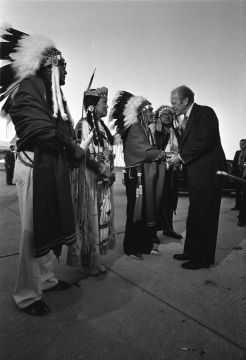1975: Indian self-determination becomes the law of the land
President Richard Nixon’s administration advances a sweeping federal policy of self-determination, repudiating the earlier policy of terminating tribes. The Indian Self-Determination and Education Assistance Act changes how the U.S. does business in Indian Country, empowering tribes to exercise their sovereignty and control their own affairs. Government agencies must now contract with Indian nations to provide services for their people that previously the federal government provided exclusively. Tribes venture into health care, education, and housing, while beginning to act more like the sovereign governments that had made treaties with the U.S. a century earlier.
“We took charge of our own destinies. We are now capable of meeting our communities’ needs more effectively than any other government. We know our people and are sensitive to their cultural traditions and realities. Our people take comfort in knowing that their governments—not the state or federal government—are making decisions on their behalf.” —W. Ron Allen, chairman of the Jamestown S’Klallam Tribe in Washington State
- Theme
- Federal-Tribal Relations
- Region
- Arctic, California, Great Basin, Great Plains, Hawai‘i, Northeast, Northwest Coast, Plateau, Southeast, Southwest, Subarctic
President Gerald R. Ford visits Oklahoma during Native American Awareness Week, Lawton, Oklahoma, 1976. Ford mentions the Indian Self-Determination and Assistance Act he signed into law in early 1975, following the resignation of President Richard M. Nixon.
Courtesy Gerald R. Ford Library
